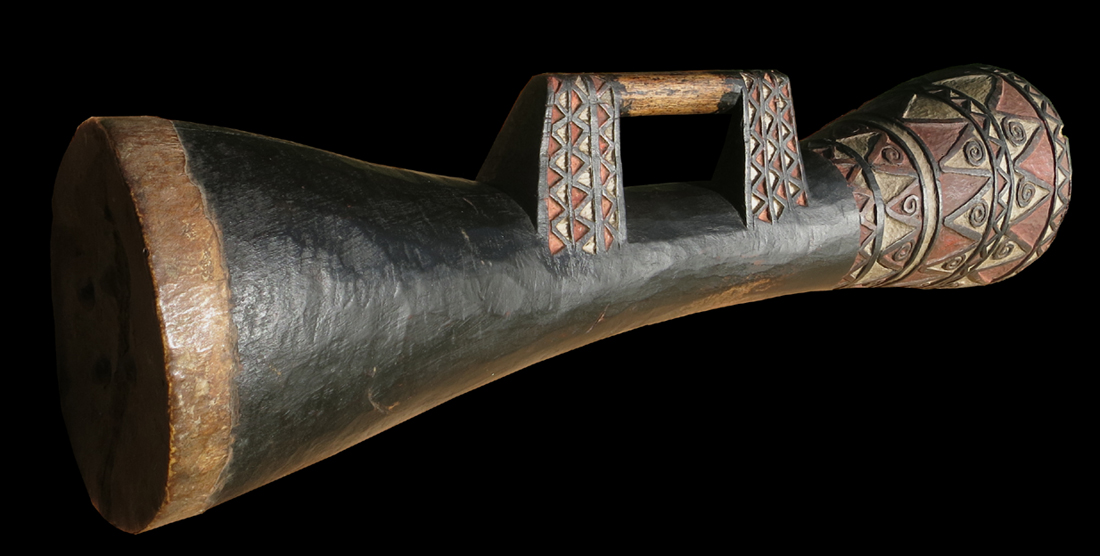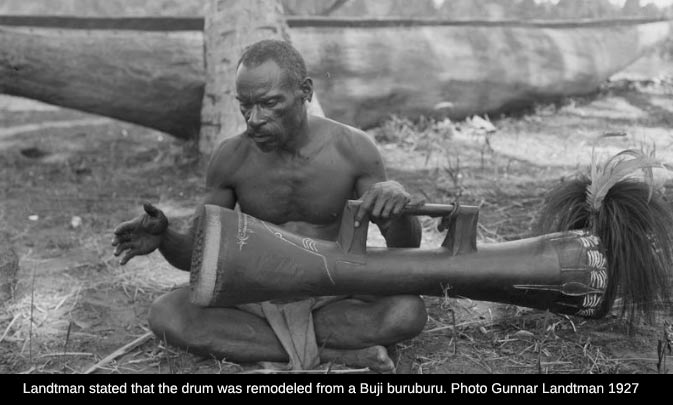DRUMS OF THE WORLD
New Guinea
Fly River drum New Guinea
Fly River - Kiwai - Torres Strait area drum New Guinea / Torres Strait Trommel Neuguinea
Drums, refashioned locally, were important trade items between the Papuan Gulf region and the Torres Strait.
"The most important musical instrument of the Kiwai was the wooden hourglass-shaped drum. This remains the major accompaniment to dances and songs in the wide Torres Strait and Fly estuary region and is even used to accompany hymns in church. There are two types of drums: the older more finely carved and decorated warupa and the more modern often over-painted buruburu. Landtman’s original comment (1927: 44) was: New drums are made at Mawatta like the Budji buruburu in shape, but provided with different decoration. It is also common practice at Mawatta to remodel imported Budji drums slightly by obliterating the original ornamentation and making the woodwork thinner by scraping them outside and inside (thereby improving the sound), then incising fresh ornamentation. He was generally correct except that the drums originated further west of Boigu in the Morehead River region. This activity is still practiced and Papuan drums are still traded into the Torres Strait Islands were they are often again redecorated with bright paint."
Excerpt from: Lawrence, David : Gunnar Landtman in Papua 1910 to 1912
"The instrument which normally accompanies the singing and the dances is the slender hour-glass-shaped drum with a wooden handle which is called burubur in Agab and gama in Owera. On one end is glued the skin of a large watersnake which can be found in the lagoons of the swampy country. One or three small lumps of beeswax are applied to the center of the drumskin for the "tuning" of the drum. This can take many hours or even days during which the wax is re-moved again and again and its size and position on the drumskin modified while it is held soft and continually kneaded with fingers which are slightly moistened with the greasy perspiration from the forehead and nose. The result aimed at is the terrific booming sound which long ago gave rise to the episode of the drum which, in the famous Sido myth, called the name of the girl Sagaru during a dance. Although there are only regular drum beats, with an occasional tattoo at the end of a song, the resounding voice of the burubur adds quite a particular sound to the papuan music. The drums are not all locally made; they are often obtained by barter from the tribes further inland, the so-called "bush tribes". The bodies of the drums are blackened and polished with coconut oil."
Excerpt from: Laade Wolfgang : Music from South New Guinea. Asch Records – AHM 4216 Vinyl 1971. Music from South New Guinea presents the music of tribes settled between the Fly River and the West Arian.
"The drum has a wide distribution, apparently having been introduced by the Tugeri (Marind-anim) from Dutch New Guinea. It is now found amongst all the Tribes from the Bensbach River to the Wiram country in the Middle Fly, down to the mouth of that river, and on to the Islands of the Torres Straits." Excerpt from: Massola, Aldo 1957 “Drum Types of Eastern New Guinea", Victoria National Museum Memoirs.
Bibliography:
Beardmore, E., The natives of Mowat, Daudai, New Guinea. Journal of the Anthro-pological Institute XIX, London, 1890.
Beaver, W. N.: Unexplored New Guinea. London, 1920.
d´Albertis, L. M.: New Guinea -What I did and what I saw. London, 1880.
Gill,W. W.: Life in the southern isles. London, 1876. pp. 231-242.
Haddon, A. C.:-Reports of the Cambridge An-thropological Expedition to Torres Straits. Vol. 1, Cambridge, 1935.
Laade, W.: Tales from the west coast of Papua. Archiv f. Volkerkunde 22, Vienna, 1968.
Laade Wolfgang : Music from South New Guinea. Asch Records – AHM 4216 Vinyl 1971.
Landtman, Gunnar: The Kiwai Papuans of British New Guinea. London 1927.
Landtman, G.: The folk-tales of the Kiwai Papuans. Acta Societatis Scientiarum Fennicae XLVII, Helsingfors, 1917.
Lawrence, David : Gunnar Landtman in Papua 1910 to 1912
Massola, Aldo 1957 “Drum Types of Eastern New Guinea", Victoria National Museum Memoirs.
Riley, E. Baxter: Among papuan headhunters. London, 1925.
Schultze-Westrum, Th. G.: Anthropological research in the Western district of Papua, with bibliography. Bulletin of the International Committee on Urgent Anthropological and Ethnological Research 7, Vienna, 1965.
Stone, O. C.: A few months in New Guinea. London, 1880.
Strachan, J .: Explorations and adventures in New Guinea. London, 1888.
Williams, F. E.: Papuans of the Trans-Fly. Oxford, 1935.
Wirz. Paul: Die Marind-anim von Holländisch-Süd-Neu-Guinea. Hamburg, 1922 and 1925.
Drums, refashioned locally, were important trade items between the Papuan Gulf region and the Torres Strait.
"The most important musical instrument of the Kiwai was the wooden hourglass-shaped drum. This remains the major accompaniment to dances and songs in the wide Torres Strait and Fly estuary region and is even used to accompany hymns in church. There are two types of drums: the older more finely carved and decorated warupa and the more modern often over-painted buruburu. Landtman’s original comment (1927: 44) was: New drums are made at Mawatta like the Budji buruburu in shape, but provided with different decoration. It is also common practice at Mawatta to remodel imported Budji drums slightly by obliterating the original ornamentation and making the woodwork thinner by scraping them outside and inside (thereby improving the sound), then incising fresh ornamentation. He was generally correct except that the drums originated further west of Boigu in the Morehead River region. This activity is still practiced and Papuan drums are still traded into the Torres Strait Islands were they are often again redecorated with bright paint."
Excerpt from: Lawrence, David : Gunnar Landtman in Papua 1910 to 1912
"The instrument which normally accompanies the singing and the dances is the slender hour-glass-shaped drum with a wooden handle which is called burubur in Agab and gama in Owera. On one end is glued the skin of a large watersnake which can be found in the lagoons of the swampy country. One or three small lumps of beeswax are applied to the center of the drumskin for the "tuning" of the drum. This can take many hours or even days during which the wax is re-moved again and again and its size and position on the drumskin modified while it is held soft and continually kneaded with fingers which are slightly moistened with the greasy perspiration from the forehead and nose. The result aimed at is the terrific booming sound which long ago gave rise to the episode of the drum which, in the famous Sido myth, called the name of the girl Sagaru during a dance. Although there are only regular drum beats, with an occasional tattoo at the end of a song, the resounding voice of the burubur adds quite a particular sound to the papuan music. The drums are not all locally made; they are often obtained by barter from the tribes further inland, the so-called "bush tribes". The bodies of the drums are blackened and polished with coconut oil."
Excerpt from: Laade Wolfgang : Music from South New Guinea. Asch Records – AHM 4216 Vinyl 1971. Music from South New Guinea presents the music of tribes settled between the Fly River and the West Arian.
"The drum has a wide distribution, apparently having been introduced by the Tugeri (Marind-anim) from Dutch New Guinea. It is now found amongst all the Tribes from the Bensbach River to the Wiram country in the Middle Fly, down to the mouth of that river, and on to the Islands of the Torres Straits." Excerpt from: Massola, Aldo 1957 “Drum Types of Eastern New Guinea", Victoria National Museum Memoirs.
Bibliography:
Beardmore, E., The natives of Mowat, Daudai, New Guinea. Journal of the Anthro-pological Institute XIX, London, 1890.
Beaver, W. N.: Unexplored New Guinea. London, 1920.
d´Albertis, L. M.: New Guinea -What I did and what I saw. London, 1880.
Gill,W. W.: Life in the southern isles. London, 1876. pp. 231-242.
Haddon, A. C.:-Reports of the Cambridge An-thropological Expedition to Torres Straits. Vol. 1, Cambridge, 1935.
Laade, W.: Tales from the west coast of Papua. Archiv f. Volkerkunde 22, Vienna, 1968.
Laade Wolfgang : Music from South New Guinea. Asch Records – AHM 4216 Vinyl 1971.
Landtman, Gunnar: The Kiwai Papuans of British New Guinea. London 1927.
Landtman, G.: The folk-tales of the Kiwai Papuans. Acta Societatis Scientiarum Fennicae XLVII, Helsingfors, 1917.
Lawrence, David : Gunnar Landtman in Papua 1910 to 1912
Massola, Aldo 1957 “Drum Types of Eastern New Guinea", Victoria National Museum Memoirs.
Riley, E. Baxter: Among papuan headhunters. London, 1925.
Schultze-Westrum, Th. G.: Anthropological research in the Western district of Papua, with bibliography. Bulletin of the International Committee on Urgent Anthropological and Ethnological Research 7, Vienna, 1965.
Stone, O. C.: A few months in New Guinea. London, 1880.
Strachan, J .: Explorations and adventures in New Guinea. London, 1888.
Williams, F. E.: Papuans of the Trans-Fly. Oxford, 1935.
Wirz. Paul: Die Marind-anim von Holländisch-Süd-Neu-Guinea. Hamburg, 1922 and 1925.


